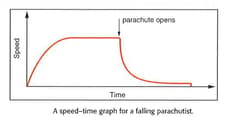An astronaut has a mass of .
Calculate her weight on the surface of the Earth.

Important Questions on Forces and Motion
An astronaut has a mass of .
The astronaut travels to Mars, where gravity is weaker. The acceleration of free fall on the surface of Mars has a value . Calculate her weight on Mars.
Look at the speed-time graph of figure. Find a point where the graph is sloping upwards.

Is the parachutist accelerating or decelerating
Look at the speed-time graph of figure. Find a point where the graph is sloping upwards.
.png)
Which of the two forces acting on the parachutist is greater
Look at the speed-time graph of figure. Find a point where the graph is sloping upwards.

Explain the shape of the graph after the parachute has opened.
What force is needed to give a car of mass an acceleration of
